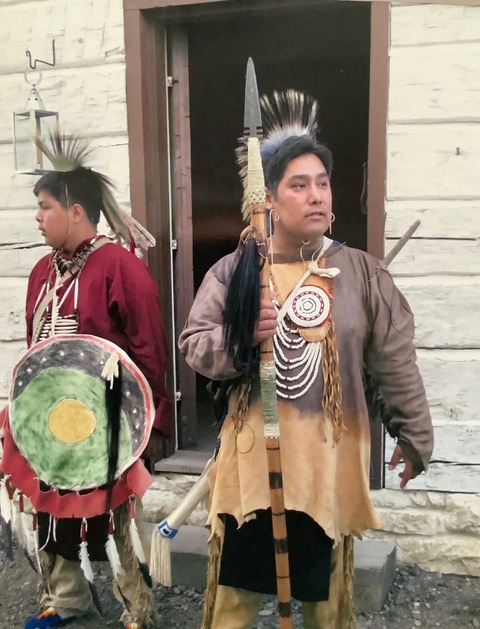My first memory of American Indians came when I was about four years old, and living in Cody, Wyoming. It was during the Korean War, and my dad was on assignment in Thailand. Dad was part of a US Navy squadron that took a load of planes to Thailand and taught the pilots there how to use and maintain them. It was the beginning of the Thai Air Force.
Mom and my older sister Karen – she was five – and I went to live in a little house behind my grandparents’ boarding house in Cody on Beck Street. It was called Baier Rooms and Apts. My cousin David Trask, also five or so, called it Baier Rooms and Apes, and so it has always remained in my mind. The boardinghouse is gone, but the memories make me smile.
When we were in Cody in the summer, Grandpa and Grandma took us downtown in the evening to watch the Indians dance in the street. To me they were basic Indians, but now I imagine they were probably Shoshone. They passed around a basket when they finished, then left. I don’t know where they went. I was four. I never lost my interest.
Many years later when I was a ranger at Fort Laramie National Historic Site, I learned more about Native Americans from the perspective of the U.S. Army. Incidentally, I’ve never liked that term Native American. I asked an Indian once what he preferred to be called, and he told me that if you know the name of the tribal nation, use that. He told me he was Creek. This was Oklahoma. Since then, that’s what I’ve done. I learned.
When I don’t know, I prefer the Canadian term, First Nation. Most nations just call themselves The People. The Nez Perce did, and were known as Nimiipuu, The People, as in This Is Who We Are.
Some years passed. When visiting my ranger friends at Fort Laramie, they told me that some Lakota had gathered down by the Laramie River to protest the Treaty of 1868, the treaty that essentially ended the roaming for those lords of the plains. I went down there and listened to their side. Finally, I told them I was a writer, and asked one old gentleman what I could do. “Tell the truth,” he told me promptly. I’ve tried to do that ever since.
It can be tricky. I know better than to think I understand The People’s mind. When I wrote Her Smile, I knew I had to tell the Nimiipuu story from the point of view of an outsider. Elizabeth Ann Everett is such a person. She knows she will always be an outsider, even as she learns to love The People. By then, she also realizes that she is This Is Who I Am.
One kind reviewer of Her Smile on Amazon wrote this: “The story written from a first-person perspective is genius.” Thank you, sir, but it could only be told that way, from the POV of a young woman who stumbles about, wondering how on earth she is going to get out of her current predicament. At least, until she realizes that as a part of The People (however inadvertently) she is now lumped with them, for good or ill, until the journey’s sad end. It’s Elizabeth Ann’s story to tell. Because I, as a pasty white writer, can never know The People’s mind, I had better not pretend to. She would have been displeased with me, had I tried.
I like the idea of Indigenous Peoples’ Day replacing Columbus, who was perhaps the first Italian – not the first European – to visit the New World. Columbus was no prizewinner. But there is this: We don’t know nearly enough about The People who were here first, so let’s not just change the name of a holiday and call it good. There’s much to be done – better water on the reservations, better schools, defeating a pesky resurgence of TB, taking a serious look at the murder of young Indian women by human predators, but no reckoning.
I like The People’s endurance. I respect it, admire it, and am in awe of it. Some things make me smile. When I rangered at Fort Union Trading Post NHS on the Montana/North Dakota border, I remember the occasional porcupine roadkill. Sure as the world, a return visit to the highway showed the same defunct porcupine, but with this difference: there was a wide strip cut out of its back. Resourceful People were going to dry those quills and use them in making bracelets and other ornamentation. I have two such bracelets and I treasure them. I suppose Indian boarding schools of years ago frowned on indigenous artists following the old ways. Too bad. The People probably listened politely, then went about their usual porcupine quill artistry. They endured. They still do. It’s an admirable trait.
I learned a lot, working at Fort Union. I learned how to carry on a conversation. One doesn’t rush into the subject – slam, bam. One inquires about the caller’s family, finds out how things are going, and then asks the question. It’s much more civilized.
I’ve been away from Fort Union for 17 years and I miss my tribal friends. I still stay in touch with Loren Yellow Bird, an Arikara who is chief ranger at Fort Union. I ask about his family, ask how he’s doing, ask about the fort. Had any snow yet?
I’m 74 and I’m still learning. Happy Indigenous People’s Day, friends.
